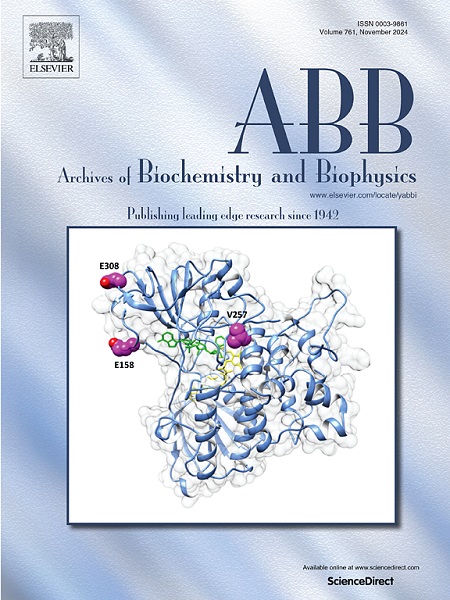mxene包封ZIF-8@Liposomes用于nir增强光热疗法在肝细胞癌治疗中的应用:体外、体内和硅研究
IF 3.8
3区 生物学
Q2 BIOCHEMISTRY & MOLECULAR BIOLOGY
引用次数: 0
摘要
光热疗法(PTT)利用近红外(NIR)光来增强局部,非侵入性癌症治疗和药物输送系统(DDS)。联合化疗与PTT(化疗-PTT)具有多种治疗优势,包括协同作用,减少副作用,降低药物毒性。在这项研究中,二维碳化钛(Ti3C2Tx) MXene纳米片被包裹在沸石咪唑盐框架-8 (ZIF-8)中,形成(MX-ZIF-8)纳米颗粒(NPs)用于PTT应用。将抗肿瘤药物索拉非尼(SB)装载到MX-ZIF-8上,并用脂质体(LPs)脂质双分子层进一步修饰,形成(SB-MX-ZIF-8@LPs)纳米复合材料。透射电镜(TEM)成像结果表明,SB-MX-ZIF-8@LPs具有片层状结构和球形结构,平均直径为75.2 nm, ZP为-8.4±4.5 mV。此外,还评估了SB-MX-ZIF-8@LPs的PT稳定性、药物包封性和体外释放动力学。这些纳米复合材料在50 μg/mL近红外照射下的PT转化效率达到55%。近红外条件下,SB-MX-ZIF-8@LPs在pH 7.4和pH 4.8条件下,SB的累积释放量分别为86.15%和89.3%,包封率为87.34%。MTT实验显示对HepG2细胞有较强的细胞毒性,SB-MX-ZIF-8@LPs的IC50值为2.7 μg/mL,诱导约96%的细胞凋亡。SB-MX-ZIF-8@lip纳米复合材料在血清环境中表现出优异的生物稳定性,在30天内保留了98%以上的索拉非尼并保持一致的粒径(~ 347 nm)。一项针对BALB/c小鼠的体内异种移植研究进一步证明了SB-MX-ZIF-8@LPs的疗效,与其他治疗组相比,该治疗组的肿瘤体积最小,肿瘤体积缩小率明显高于单用SB。分子对接研究表明,SB与ABL1 (-8.7 kcal/mol)和EGFR (-9.3 kcal/mol)具有较强的结合亲和力。利用Hdock Server进行MXene与SB的对接交互,其对接得分为-10.53,在4 Å的距离处形成一个键。这些发现与实验结果一致,突出了MXene和SB之间良好的相互作用。ADMET分析证实MX-ZIF-8@LPs具有良好的药物载体特性,包括高肠吸收(96.6%)和低毒性,支持其作为癌症治疗的有效DDS的潜力。本文章由计算机程序翻译,如有差异,请以英文原文为准。

MXene-encapsulated ZIF-8@Liposomes for NIR-enhanced photothermal therapy in hepatocellular carcinoma treatment: In vitro, in vivo, and in silico study
Photothermal therapy (PTT) utilizes near-infrared (NIR) light to enhance localized, non-invasive cancer treatments and drug delivery systems (DDS). Combination chemotherapy with PTT (chemo-PTT) offers multiple therapeutic advantages, involving synergistic effects, reduced side effects, and decreased drug toxicity. In this study, 2D titanium carbide (Ti3C2Tx) MXene nanosheets were encapsulated in a zeolitic imidazolate framework-8 (ZIF-8) to form (MX-ZIF-8) nanoparticles (NPs) for PTT applications. Sorafenib (SB), an anticancer drug was loaded onto MX-ZIF-8 and further modified with a liposomes (LPs) lipid bilayer to create (SB-MX-ZIF-8@LPs) nanocomposites. TEM imaging revealed that SB-MX-ZIF-8@LPs had a lamellar structure and spherical shape, with an average diameter of 75.2 nm and a zeta potential (ZP) of −8.4 ± 4.5 mV. Additionally, the PT stability, drug encapsulation, and in-vitro release kinetics of SB-MX-ZIF-8@LPs were assessed. These nanocomposites exhibited an impressive PT conversion efficiency of 55 % at 50 μg/mL under NIR irradiation. The cumulative release of SB from SB-MX-ZIF-8@LPs reached 86.15 % at pH 7.4 and 89.3 % at pH 4.8 under NIR over a period of 72 h, with an encapsulation efficiency of 87.34 %. MTT assays revealed strong cytotoxicity against HepG2 cells, with SB-MX-ZIF-8@LPs showing an IC50 value of 2.7 μg/mL and inducing approximately 96 % total apoptosis. The SB-MX-ZIF-8@lip nanocomposite demonstrated excellent biological stability in a serum environment, retaining over 98 % of sorafenib and maintaining consistent particle size (∼347 nm) over 30 days. An in vivo xenograft study in BALB/c mice further demonstrated the efficacy of SB-MX-ZIF-8@LPs, with this treatment group showing the smallest tumor volume compared to other groups and a significantly higher tumor volume reduction than SB alone. Molecular docking studies indicated that SB exhibited strong binding affinities particularly with ABL1 (−8.7 kcal/mol) and EGFR (−9.3 kcal/mol). Docking interactions between MXene and SB, conducted using the Hdock Server, resulted in a docking score of −10.53, with one bond forming at a distance of 4 Å. These findings were consistent with experimental results, highlighting the favorable interaction between MXene and SB. ADMET analysis confirmed that MX-ZIF-8@LPs possessed favorable drug carrier properties, including high intestinal absorption (96.6 %), and low toxicity supporting its potential as an effective DDS for cancer therapy.
求助全文
通过发布文献求助,成功后即可免费获取论文全文。
去求助
来源期刊

Archives of biochemistry and biophysics
生物-生化与分子生物学
CiteScore
7.40
自引率
0.00%
发文量
245
审稿时长
26 days
期刊介绍:
Archives of Biochemistry and Biophysics publishes quality original articles and reviews in the developing areas of biochemistry and biophysics.
Research Areas Include:
• Enzyme and protein structure, function, regulation. Folding, turnover, and post-translational processing
• Biological oxidations, free radical reactions, redox signaling, oxygenases, P450 reactions
• Signal transduction, receptors, membrane transport, intracellular signals. Cellular and integrated metabolism.
 求助内容:
求助内容: 应助结果提醒方式:
应助结果提醒方式:


